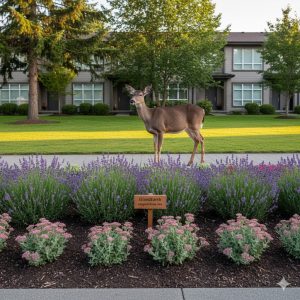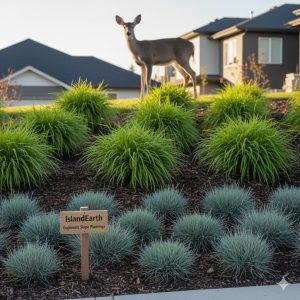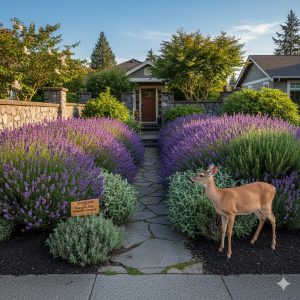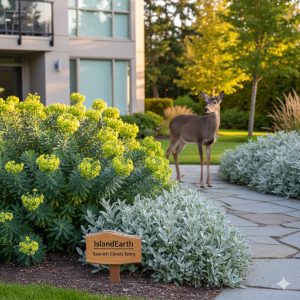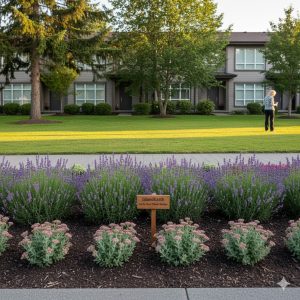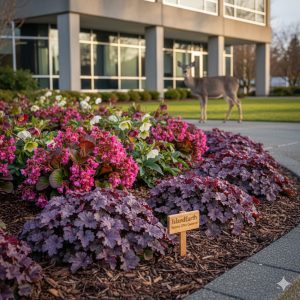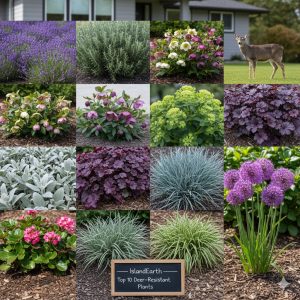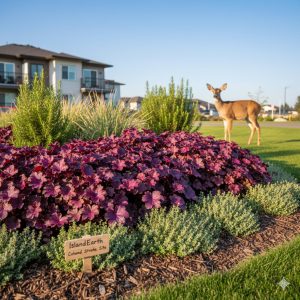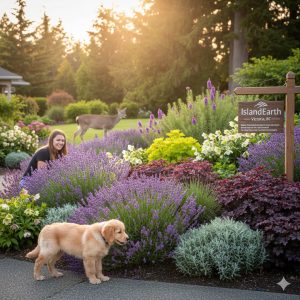Q: What deer-resistant plants actually work in Victoria, BC?
Deer avoid strongly scented, fuzzy, or toxic plants. On Vancouver Island, the best deer-resistant choices include lavender, rosemary, hellebores, euphorbia, and ornamental grasses like blue fescue. These plants hold up even when winter forage is scarce.
1️⃣ What “Deer-Resistant” Really Means
What it is: Plants that deer dislike because of taste, smell, or texture—but not 100 % deer-proof.
Why it matters: In winter, deer in Greater Victoria wander closer to gardens searching for food. Choosing deterrent species reduces damage when natural forage is low.
IslandEarth example: Our team uses mixed borders of lavender and sedum at a Langford strata site—deer walk right past, leaving blooms untouched all season.
2️⃣ Victoria’s Unique Deer Challenge
What it is: The region’s mild winters and urban greenspace create year-round browsing pressure.
Why it matters: The CRD’s “Right Plant Right Place” principle highlights matching plants to micro-climates—sun, soil, moisture—to reduce maintenance and pest stress.
IslandEarth example: In Oak Bay, we redesigned a boulevard bed using drought-tolerant herbs rather than tulips. Results: zero grazing, lower watering, higher curb appeal.
3️⃣ Scented Plants Deer Avoid
What it is: Aromatic oils overwhelm a deer’s sensitive nose.
Why it matters: These species thrive in Victoria’s Zone 9b climate and double as pollinator magnets.
IslandEarth example: Lavender, sage, and rosemary planted along entryways keep deer and rabbits back while staying evergreen through winter.
4️⃣ Textures & Toxins They Skip
What it is: Deer dislike fuzzy, spiny, or mildly toxic leaves.
Why it matters: Perfect for clay soils that hold moisture; many of these species tolerate winter damp.
IslandEarth example: Euphorbia characias ‘Wulfenii’ and lamb’s-ear form striking contrasts at a Saanich condo entry—lush foliage, zero nibbling.
5️⃣ Grasses & Groundcovers That Hold Up
What it is: Fine-textured or sharp-edged ornamental grasses and creeping mats.
Why it matters: Provide winter structure, movement, and soil protection without becoming deer salad.
IslandEarth example: Blue fescue and Japanese forest grass anchor our Esquimalt slope plantings—no fences, no damage.
6️⃣ Colour Without Deer Drama
What it is: Late-season perennials and evergreens that add tone when flowers fade.
Why it matters: Keeps commercial landscapes visually active for clients year-round.
IslandEarth example: Heuchera ‘Palace Purple,’ hellebores, and bergenia deliver deep winter colour outside a Victoria office courtyard—untouched since installation.
7️⃣ Top 10 Deer-Resistant Plants for Victoria BC
| Plant | Type | Key Benefit | Deer Reaction |
|---|---|---|---|
| Lavender (Lavandula angustifolia) | Shrub | Scented, drought-tolerant | Avoided |
| Rosemary (Rosmarinus officinalis) | Shrub | Evergreen, edible | Avoided |
| Hellebore (Helleborus orientalis) | Perennial | Winter blooms | Rarely eaten |
| Euphorbia characias ‘Wulfenii’ | Perennial | Evergreen texture | Avoided |
| Lamb’s-ear (Stachys byzantina) | Groundcover | Fuzzy leaves | Avoided |
| Heuchera ‘Palace Purple’ | Perennial | Colourful foliage | Sometimes sampled |
| Blue Fescue (Festuca glauca) | Grass | Low-clump form | Avoided |
| Japanese Forest Grass (Hakonechloa macra) | Grass | Shade tolerant | Avoided |
| Bergenia ‘Winter Glow’ | Perennial | Evergreen, pink blooms | Avoided |
| Allium (ornamental) | Bulb | Strong onion scent | Avoided |
8️⃣ Smart Planting Tips for Zone 9b
-
Mix textures and scents—deer test fewer plants when variety is high.
-
Edge beds with aromatics like thyme or oregano.
-
Plant in masses—individual specimens invite sampling.
-
Follow CRD’s “Right Plant Right Place” for moisture and sunlight.
-
Avoid attractants: tulips, hostas, pansies, ivy, and fruit trees.
IslandEarth example: At a Colwood strata, replacing hostas with massed heuchera cut grazing complaints by 95 %.
9️⃣ Mini FAQ
Q1: Are deer-resistant plants safe for pets?
Most are, but avoid euphorbia and foxglove near play areas—they contain sap toxins.
Q2: Do sprays or motion sensors help?
Yes, but pairing deterrents with resistant plants gives longer-term success.
Q3: Will deer adapt to these plants?
Rarely. In harsh winters, they might sample, but usually move on fast.
Q4: Can I still have colour in winter?
Yes—hellebores, heuchera, and bergenia offer winter tones without attracting deer.
Q5: What about native options?
Nootka rose, Oregon grape, and salal are hardy local natives deer seldom browse.
🔍 Quick Checklist — Copy & Paste
✅ Choose Zone 9b deer-resistant species (lavender, hellebore, euphorbia).
✅ Mix scents + textures = natural deterrent.
✅ Edge beds with aromatic herbs.
✅ Replace tulips, hostas, pansies.
✅ Follow CRD “Right Plant Right Place.”
✅ Inspect winter damage in March, prune lightly, and re-mulch.
🌱 IslandEarth CTA
IslandEarth designs and installs deer-resistant gardens that stay vibrant year-round. Free on-site consultation across Greater Victoria and the West Shore.
🌿 Summary
In Victoria’s mild Zone 9b climate, deer become hungriest just as gardens slow down. The best defense is a landscape filled with plants they naturally dislike—aromatic, textured, or mildly toxic species chosen using the CRD’s Right Plant Right Place guidelines. From lavender and hellebores to euphorbia and ornamental grasses, these choices protect your investment and keep commercial and residential landscapes thriving all winter long.
